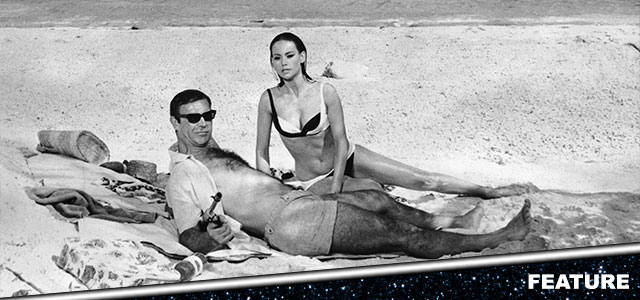
James Bond movie No Time To Die arrives in Cineworld in September, and we're counting down the days by revisiting all the 007 movies in chronological order of release.
In honour of Daniel Craig's swan-song as 007, we're taking a nostalgic trip back through time. Today's movie: Thunderball...
What is the story of Thunderball?
Following the events of Dr No and From Russia With Love, criminal organisation SPECTRE (Special Executive for Counter-Intelligence, Terrorism, Revenge and Extortion) has a diabolical new plan. Led by the mysterious Blofeld, they have stolen two atomic bombs and plan to hold the world to ransom. They're demanding a £100 million payment in diamonds, or else they will destroy an unspecified city in either the UK or the United States.
British Mi6 agent James Bond/007 (Sean Connery) is assigned to operation 'Thunderball', and sent to the Bahamas. There he comes face to face with the mastermind of the deadly plan: SPECTRE agent Number One, Emilio Largo (Adolfo Celi). He also encounters Largo's mistress Domino (Claudine Auger) and the deadly yet seductive assassin Fiona Volpe (Luciana Paluzzi).
With time ticking away, Bond must work fast to stop both Largo and SPECTRE in their tracks.
How did Thunderball get made?
By the mid-1960s, movie franchises didn't get bigger than James Bond. Throughout the course of three groundbreaking movies, the 007 series had established a globe-trotting template that mixed exotic locations with exciting set-pieces that carried audiences into cinematic nirvana. And, of course, the presence of Sean Connery in the central role helped put a human face on Ian Fleming's celebrated literary creation – in fact, so assured was Connery in the role, that even to this day he remains the definitive Bond for many people.
Dr No and From Russia With Love were relatively grounded Cold War-era thrillers, whereas Goldfinger careered into its own cartoonish world of fantasy to enormously successful effect. It was Goldfinger that secured the Bond template that would be copied throughout the decades, placing greater emphasis on campy humour and tongue-in-cheek action. The movie announced Bond as a character who was entirely untethered from Soviet-era concerns – instead, audiences could escape reality and vicariously revel in his womanising, baddie-destroying sense of panache, all carried off with an impeccable sense of style.
Interestingly, whereas Goldfinger temporarily ditched the SPECTRE storyline established in the first two Bond movies, Thunderball brought it back. At the same time, however, Thunderball clearly owes its relatively frivolous tone and self-aware sense of silliness to Goldfinger – it therefore ought to be considered as a transitional movie between the grittier, earlier Bond movies, and the increasingly outrageous Bond escapades of the 1970s and 1980s.
At the time, Sean Connery was among the biggest movie stars on the planet, but he was tiring of the press attention that Bond was bringing, particularly after being mobbed by hysterical fans at the Goldfinger premiere. He also desired to escape the confines of the role and express himself in other movies – a difficult feat to achieve when the logistics of making a Bond movie consumed pretty much all of his time. Nevertheless, Thunderball, like Goldfinger, showcases Connery at the peak of his confidence and charisma.
Thunderball was significant in the Bond canon in that it was the final 007 movie directed by Terence Young. He had brought a sense of tension and atmosphere to both Dr No and From Russia With Love, before stepping aside for Goldfinger. (That movie was directed by Guy Hamilton.) Even so, those going into Thunderball expecting the relatively more grounded atmosphere of Young's first two Bond movies may have been surprised – in this film, it's the stunts and locations that tend to dominate at the expense of the storyline.
Behind the scenes, Thunderball had been embroiled in a complicated legal wrangle. The screenplay had originally been conceived by Kevin McClory, Jack Whittingham and Ian Fleming – however, McClory and Whittingham later sued Fleming for allegedly basing his 1961 novel on their script treatment. For this reason, Thunderball was shunted around the Bond schedule by producers Albert R. 'Cubby' Broccoli and Harry Saltzman (it was originally meant to have been made before Goldfinger).
The case was eventually settled out of court – however, Broccoli and Saltzman feared that McClory, who retained the rights to the story and characters, would spearhead his own take on Thunderball. In 1964, they reached an agreement with McClory to adapt Fleming's novel, promoted as 'Ian Fleming's Thunderball', and further placated him with both a co-producer and story credit.
They labelled themselves as executive producers, whereas the screenplay was credited to Richard Maibaum and John Hopkins, with an additional 'original screenplay' credit accorded to Whittingham. Much later in 1983, McClory would realise his own take on Thunderball with the non-canonical Never Say Never Again, which marked Connery's first appearance as Bond in 12 years.
Poignantly, Thunderball was the first Bond movie to be developed in the wake of Ian Fleming's death – he passed away in August 1964 just prior to the release of Goldfinger. The author therefore wasn't present to see his creation reach increasingly ear-splitting volumes of success and excess – one suspects he might not have recognised the gimmick-laden, pun-driven world of this movie, which would directly inform the later tone of Roger Moore's tenure as 007.
Along with screenwriter Maibaum, many other members of the Bond 'stable' were retained for Thunderball, including cinematographer Ted Moore, production designer Ken Adam and composer John Barry. Principal photography began on the 16th of February 1965, primarily taking place in Nassau in the Bahamas bar a brief diversion to Paris (for the opening fight sequence), and Pinewood Studios for the interior scenes.
Thunderball is notable for the amount of energy it brings to its action sequences. At regular intervals, particularly during the opening chateau fight and the closing one on Largo's hydrofoil, the Disco Volante, the speed of the film increases to increasingly comical levels. Although it looks somewhat dated now, it was, at the time, a pioneering technique from editor Peter Hunt who lends additional urgency to Bond's battle with SPECTRE. Hunt would later bring his incisive feel for pacing and tension to his role as director for 1969's On Her Majesty's Secret Service, which showcased the sole Bond appearance from George Lazenby.
Julie Christie was Broccoli's original choice for the role of Domino, and Chinatown's Faye Dunaway also came very close to securing the part. It eventually went to French actor and model Claudine Auger. (Like many Bond women of the period, she was dubbed in post-production by Nikki Van Der Zyl.)
Thunderball is also historic in that it's the last time Blofeld's face is masked on-screen – the character was played by Anthony Dawson and voiced by Eric Pohlmann, but when he finally stepped out of the shadows in You Only Live Twice, he was embodied by a sinister Donald Pleasance.
A stand-out performance comes from Luciana Paluzzi as Fiona Volpe – during one memorable scene, after having seduced Bond she pierces right through his masculine bravado, later coming close to killing him during a pursuit through the Junkanoo parade. Volpe was originally written by Maibaum to be Irish – the Volpe surname arose when the nationality of the character changed to suit Paluzzi's Italian status.
Towards the end of filming, Connery became increasingly aggravated with press intrusion, complaining to Playboy magazine: "I find that fame tends to turn one from an actor and a human being into a piece of merchandise, a public institution. Well, I don't intend to undergo that metamorphosis". This was exacerbated by the fact that his marriage to Diane Cilento (who later acted as a body double in You Only Live Twice) was under strain.
Outside of Connery's performance, Thunderball placed a greater emphasis on hardware, weaponry and gadgets, beginning with Bond's seemingly futuristic jet pack at the very beginning of the film. Indeed, technology is writ large in the story, given that SPECTRE have co-opted two atomic weapons for nefarious purposes. Visual effects supervisor John Stears, who would win an Oscar for his work on the movie, was involved in the more technically complicated sequences. He had invented the gadgets on the Aston Martin DB5 seen in Goldfinger (and which turns up briefly in Thunderball), and would later pioneer many of the famous effects on Star Wars, including the lightsabers.
Stears would eventually win an Oscar for his work on Thunderball, although like Connery, he grew increasingly disillusioned with the franchise. Memorably, during the sequence where Bond swims through Largo's shark-infested swimming pool, Stears and his team were faced with a supposedly dead creature that suddenly revived.
Little wonder that Connery was queasy about filming the sequence – he insisted that Ken Adam build a plexiglass screen between himself and the sharks, but one managed to get past, prompting the actor to flee for his life. During an earlier sequence where Largo's henchman Quist is thrown to the man-eaters (a trope that would be repeated in many other Bond movies), stuntman Bill Cummings demanded an extra fee of £250 as he was dropped into the pool.
"We had to use special effects, but unlike special effects today, they were real," Adam later told The Guardian. "The jet pack we used in Thunderball was real – it was invented for the United States Army. Bloody dangerous, and it only lasted a couple of minutes. The ejector seat in the Aston Martin was real and Emilio Largo's boat, the Disco Volante, was real."
Adam continued: "You had power boats at that time, but there were no good-sized yachts that were able to travel at 40 to 50 knots, so it was quite a problem. But by combining a hydrofoil, which we bought in Puerto Rico for $10,000, and a catamaran, it at least looked like a big yacht. We combined the two hulls with a one-inch slip bolt and when they split it worked like a dream. We used lots of sharks for this movie.
"I'd rented a villa in the Bahamas with a saltwater pool which we filled with sharks and used for underwater filming. The smell was horrendous. This was where Sean Connery came close to being bitten. We had a plexiglass corridor to protect him, but I didn't have quite enough plexiglass and one of the sharks got through. He never got out of a pool faster in his life – he was walking on water."
The underwater sequences that dominate Thunderball were revolutionary for their time (even if, on repeat viewings, they slow the pace and make the distinction between good guys and bad guys incomprehensible). The climactic underwater battle was shot at Clifton Pier and was choreographed by Hollywood expert Ricou Browning, who had worked on classic 1954 horror Creature From the Black Lagoon. In exchange for a merchandising deal, the Voit Corporation provided much of the underwater gear.
After sitting out From Russia With Love and Goldfinger, title designer Maurice Binder returned to sculpt his now signature blend of women's silhouettes and psychedelic visuals during the opening credits sequence. Given Thunderball was the first Bond movie shot in Panavision, the gunbarrel sequence had to be staged again – only this time, it was Connery on-screen, not stuntman Bob Simmons.
READ MORE
- No Time To Die and the 6 James Bond movies we never got to see
- 7 actors who could play James Bond after Daniel Craig retires
- Shaken and stirred! Daniel Craig's defining 007 moments
What music is on the Thunderball soundtrack?
John Barry was officially cemented as the musical voice of Bond by the time Thunderball appeared. The composer was uniquely suited to the Bond character: Barry was a prominent figure in swinging sixties London, having been briefly married to glamorous model and actor Jane Birkin while fronting his own jazz ensemble, the John Barry Seven. Combine all that with his intuitive sense of rhythm and melody, and it's little wonder that Barry's Bond legacy is a formidable one.
In 1964, Goldfinger became the first 007 movie to feature Barry's signature style on both the title song and the underscore. (Harry Saltzman, however, famously hated Shirley Bassey's full-throated delivery.) Come 1965, and there was no question that Barry exerted complete autonomy over the Thunderball soundtrack (Barry's status was later boosted by his first Oscar win for the gorgeous Born Free soundtrack, composed in 1966).
Although the title track 'Thunderball' demonstrates the impressive lungs of Welsh supremo Tom Jones, it was originally intended for Dionne Warwick. Indeed, Barry and lyricist Leslie Bricusse had recorded a song with Warwick, saucily named 'Mr Kiss Kiss Bang Bang', owing to the fact that it was difficult to base a song around the word Thunderball. However, there were concerns about Warwick's delivery and Goldfinger vocalist Bassey was drafted in to sing a replacement.
Eventually, the song was dropped altogether, after United Artists requested that the film's title feature in the music itself. The resulting 'Thunderball' tune was composed hastily by Barry with lyrics from Don Black, after a song from Johnny Cash was turned down. (Warwick and Bassey's original efforts were eventually released in the 1990s.) That famously protracted last note caused Tom Jones to pass out in the midst of recording: "I closed my eyes and I held the note for so long when I opened my eyes the room was spinning".
The somewhat fraught nature of the recording meant Barry faced complications when integrating the song melody into his underscore. Instrumental variations of 'Mr Kiss Kiss Bang Bang' were meant to have been used throughout, but for the most part he was forced to rework his score around the new 'Thunderball' melody. ('Mr. Kiss Kiss Bang Bang' can still be heard in key tracks, including 'Death of Fiona' when the treacherous Fiona Volpe meets her end.)
It's a testament to Barry's skill that the Thunderball soundtrack is as coherent and exciting as it is. In the manner of Goldfinger, the rambunctious brass and timpani were turned up to 11 to mirror the increasingly outrageous nature of Bond's escapades, not to mention the sultriness of many of the female characters. Although many other composers have contributed to Bond over the years, none of them distilled the raw sexual charisma of the character quite like Barry did.
The numerous underwater set-pieces also posed an interesting challenge. Given the motion of the characters on the screen was visibly slowed, Barry had to alter the tempo of his music to suit, placing greater emphasis on timpani and moody bass flutes to match the action. These brilliantly atmospheric touches would underpin all of Barry's later Bond works.
Significantly, Thunderball reintroduces the secondary '007 Theme' that was last heard in From Russia With Love. A rambunctious march for brass and timpani, it meshed effectively with the increasingly OTT direction that the series was taking. This is most apparent during the climactic Disco Volante fight – one suspects that Barry was over-compensating for the slightly awkward choreography and clunky back projection. Said theme would later appear in Diamonds are Forever and Moonraker before vanishing from the series altogether.
How was Thunderball received?
The Thunderball premiere was held on the 9th of December 1965 in Tokyo (anticipating the Japan-based action of You Only Live Twice), and again on the 29th of December 1965 in London. In fact, during its UK bow, Thunderball premiered at two different cinemas on the same night: the Pavilion and the Rialto.
It became a sensational box office success, with global grosses of $141.2 million against a $9 million budget. When adjusted for inflation, Thunderball remains the second most successful Bond movie to date with $1.129 billion in the bank. This places it second only to 2012's Skyfall ($1.218 billion), and ahead of Goldfinger ($1.015 billion).
Critical reaction was largely positive, although many (including Connery himself) bemoaned the franchise's increased emphasis on gadgetry. Yet Connery himself was singled out for praise. Dilys Powell of The Sunday Times remarked after seeing the film that "The cinema was a duller place before 007."
Yet contemporary critics are somewhat cooler on the movie. Writes David Kehr in the Chicago Reader: "[Thunderball is] slightly bloated Bond, with too much technology for my taste and a climactic slaughter that's a little too mindless to be much fun".
Nevertheless, the film was an awards success as well as a financial one. John Stears won an Oscar for his pioneering special effects and stalwart production designer Ken Adam was BAFTA nominated.
Nevertheless, it was becoming increasingly apparent that the Bond franchise was finding it harder and harder to remain on the ground. And this became more of an issue in the next instalment...
What was the next movie in the James Bond series?
You Only Live Twice was the next Bond movie, released in 1967.
When is No Time To Die released in the UK?
No Time To Die is released on 30th September. Don't forget to tweet us your favourite James Bond movies @Cineworld.

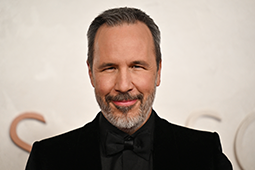
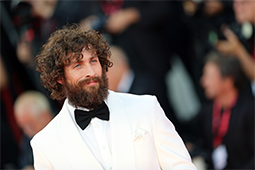
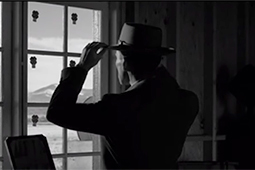
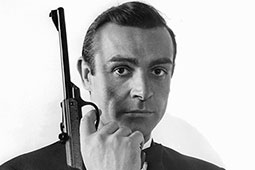
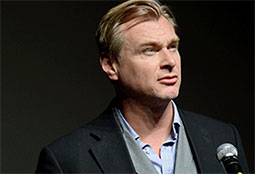
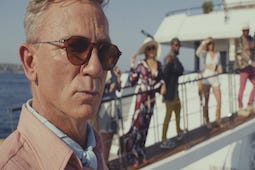
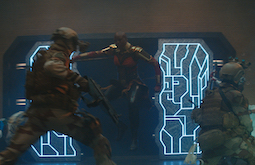
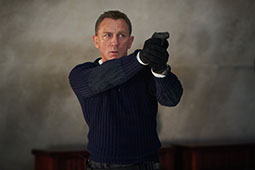
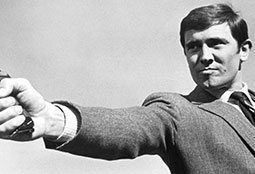
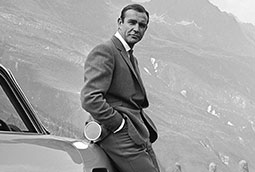


.jpg)
.png)






